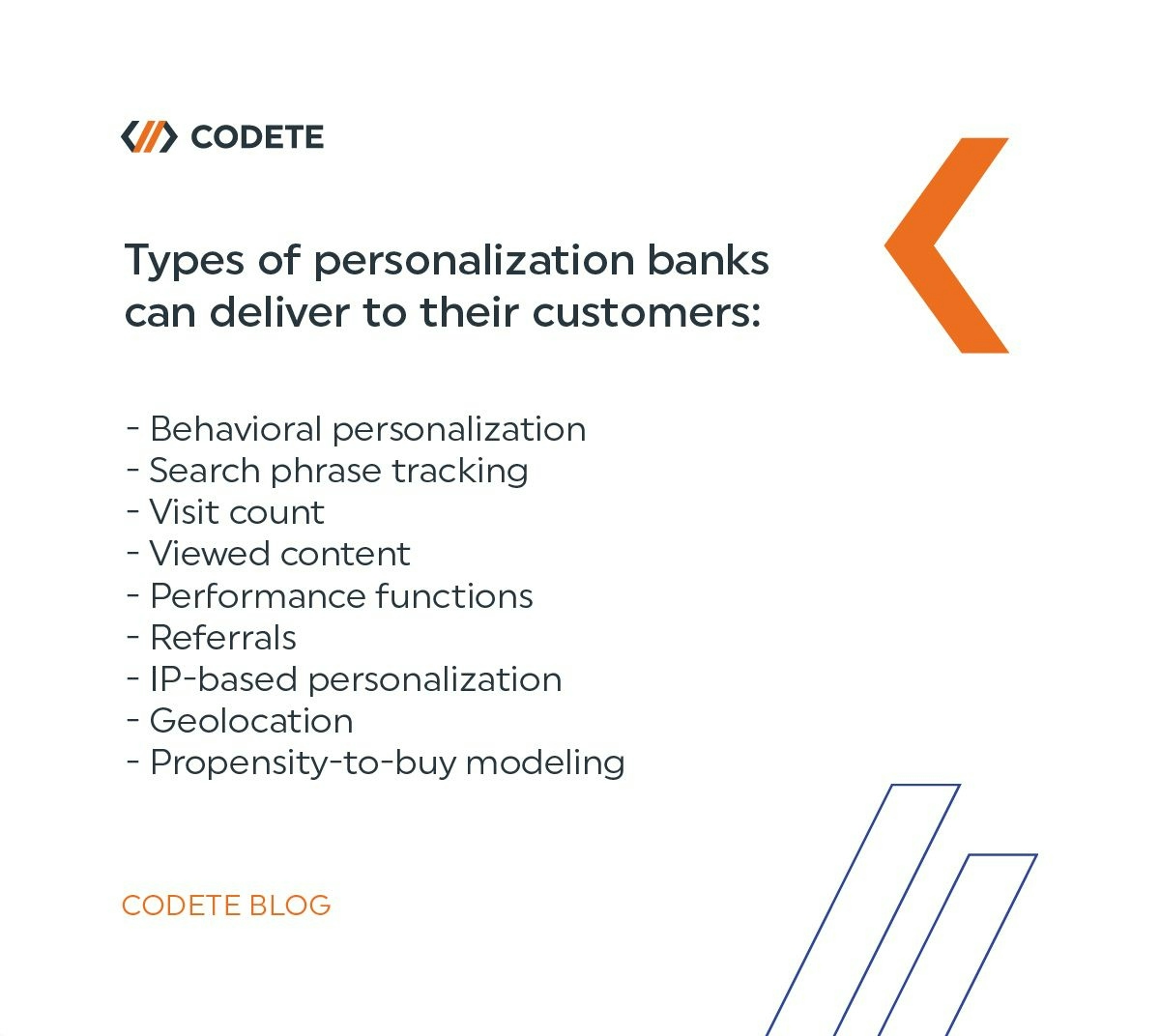Today consumers want to be treated specially in every business relationship, no matter if it concerns their taste in clothing or banking products. Placing customers in segments defined by demographic data isn't enough to deliver this type of experience anymore.
Companies now differentiate customers based on the depth, length, and value of their relationship with the brand. And consumers are used to organizations collecting data about them. That's why they look forward to signs that companies learn about their preferences and habits. And that is especially true for organizations where consumers take advantage of digital services.
Banking is not an exception to the trend for tailormade experiences. But how can banks deliver a hyper-personalized experience to customers?
Read this article to find out what hyper-personalization is all about and how banks are now using technology solutions to provide their customers with outstanding experiences.
Table of contents:
- What is hyper-personalization?
- Benefits of hyper-personalization for businesses
- How can banks implement hyper-personalization tools?
- Personalization – the future of banking
- How to deliver personalized services in banking
- Moving to hyper-personalization
What is hyper-personalization?
Hyper-personalization takes advantage of real-time data and cutting-edge technologies like artificial intelligence (AI) to deliver the more relevant product or service information to users. It's an approach that takes personalization as we know it a step further. Such solutions integrate customer data from multiple sources to create comprehensive profiles that are then used by predictive analytics tools to generate the most relevant recommendations and products.
Investing in hyper-personalization tools is a smart strategy; companies can gain the trust of their customer base, increase the rate of conversion, and see higher rates of repeat customer business. Famous for its amazing personalization engine, Amazon generates over $100 million per day thanks to such targeted and personalized recommendations.
Benefits of hyper-personalization for businesses
- The major advantage of hyper-personalization in banking is that it makes your offer much more accessible. It allows banks to remove the obstacles in the sales funnel and create an uncluttered shopping experience.
- Such tools also eliminate the problem of choice overload. This helps to solve a common problem in the banking sector, where there are many product variants customers can choose from, and the products themselves might not be crystal clear. Some customers may feel overwhelmed with such a wide range of options. Personalization tools provide them only with the options they are looking for.
- Attracting customer attention is difficult, but if you do so with information about their preferences, you're more likely to be successful. Hyper-personalized tools help to address customer pain points and save time on looking for the most suitable solutions.
How can banks implement hyper-personalization tools?
Most companies can achieve all of the benefits we mentioned above by delivering personalized services. That's why it's important to choose the types of personalization applicable to the largest segment of the customer base with the help of custom analytics and personalization tools.
Such tailormade solutions stand to help banks deliver different types of personalization:
- Behavioral personalization - which determines the visitor's interest in the product offering based on their behavior and actions they take on the website.
- Search phrase tracking - analyzing the search phrases used by visitors on the site allows customizing the user experience during future visits.
- Visit count - this type of personalization is based on showing different content to new visitors, returning visitors, and visitors who have visited the site multiple times and are probably active customers.
- Viewed content - when a visitor views specific content, the tool can customize their experience during current and future visits.
- Performance functions - when a visitor completes a task such as starting a deposit application or using a calculator, the tool will track this and personalize the future experience by displaying relevant support and marketing content.
- Referrals - if a visitor arrives at the company website from a referral site, the tool can customize the experience accordingly.
- IP-based personalization - this type of personalization is based on information about the user's IP address and DNS records.
- Geolocation - based on the city, metro area, state, or country the visitor is coming from, the tool can show local images or display content in the local language to improve the experience.
- The propensity to buy - this type of personalization is based on the visitor's behavior on the public website. Based on this data, the tool can create a propensity model that will drive personalization in promotional areas of the site.
Personalization – the future of banking
A 2019 report “Banking of the Future: Finance in the Digital Age” from HSBC about the future of banking within the next 10 years pointed to hyper-personalization as the next rising trend. The report revealed that digital banking has already become the new normal. 87% of the bank's global retail transactions are already carried out digitally. And with the continuing digitalization and access to consumer data, customers may become in control of their data through special digitized ID profiles. The authors of the report see this shift as an opportunity for banking institutions to serve as trust brokers forming closer relationships with their customers.
Banks will increasingly take advantage of technology solutions to better organize and analyze their customer data. Owing to their trusted position in building the relationship with customers among other sectors, banks are going to expand their role to become real financial services providers. And becoming a trusted broker is essential to this success.
That's why banks will be investing in personalization tools that will help their customers better and deliver the most relevant financial opportunities at the right time. It's safe to say that hyper-personalization is going to become a critical interest in financial services institutions all over the world.
How to deliver personalized services in banking
Sending automated messages today feels as if the company didn't take time to get to know its customer base and decided to mass deliver such communications. Doing that is, of course, better than doing nothing. But this type of personalization isn't really personal anymore from the perspective of consumers. Your customers will be able to see through the automated communications and note that you don't make an effort in establishing a meaningful relationship with them.
How can you address this problem? By implementing custom solutions powered by predictive analytics, artificial intelligence, and machine learning bring hyper-relevant capabilities for delivering real-time messages. Banking companies can use both internal and external data to increase the contextuality and timeliness of their messages. According to Accenture's 2019 Global Financial Services Consumer Study | Accenture, banks need two important elements to deliver the right level of personalized services and experiences:
- The first is customer insight. To achieve the level of hyper-personalization, you need more than just the traditional data points like demographic information, services held, length of the relationship, and balances. You need to understand detailed customer behaviors such as interactions with the brand, purchase history, social interactions, and even insights into key life events or health. All of this information allows creating an insightful customer profile you can use to deliver the most relevant marketing messages.
- The other element is customer trust. In-depth analytics rely on establishing a trusting relationship with your customer base. Trust can only be built over time and requires continuous interaction with consumers. A single misstep can compromise all the hard work you've been doing to gain the trust of your customer base. That's why it's important to take more precautions than ever to protect personal data if you want to provide such digital interactions.
Moving to hyper-personalization
A personalization strategy is no longer enough to engage customers. For banking institutions to go forward, they must deliver real-time, contextual, and hyper-relevant interactions. That's the only way they can survive in the marketplace, gain a competitive edge, and address the evolving demands of customers.
Companies such as Netflix, Amazon, Airbnb, and other tech giants are behind the rise of these consumer expectations. They apply digital tools to offer an omnichannel experience and show that they're looking out for the customer's best interest. Here are a few pointers to help you jump on the hyper-personalization bandwagon:
- Remember, there's more than the customer journey. While understanding the customer journey is important, it pays to be one step ahead and provide recommendations about products that might become relevant to the customer in the future. The "next best action" type of software solutions helps to do exactly that.
- Look beyond traditional data sources. Such sources can only provide you with insight and descriptive analytics - they tell you what has happened. To provide hyper-personalized experiences, you need to know what is going to happen. And to accomplish that, you need predictive analytics tools. Note that if you collect and analyze data from non-traditional sources, ensuring their security will become even more important.
- Invest in building trust. Financial services companies operate in one of the most trusted industries. However, you will need to leverage and expand this trust to become the trust protector of your customers' identities across different platforms and daily interactions with your brand. A single poorly targeted communication or irrelevant offer may compromise that trust. So be sure that every single message you send to your customer base is spot on.
Hyper-personalization in banking - wrap up
The evolving consumer demands force organizations across different industries to move beyond mass communications and invest in personalized content. The leading companies in the financial services sector are already taking advantage of advanced analytics tools to deliver more personalized offerings.
Are you looking for a team of experts who know how to build analytics tools for personalization? Get in touch with us and let's talk about your project. Our experts have delivered numerous applications to financial services companies to help them increase engagement and inspire trust.



